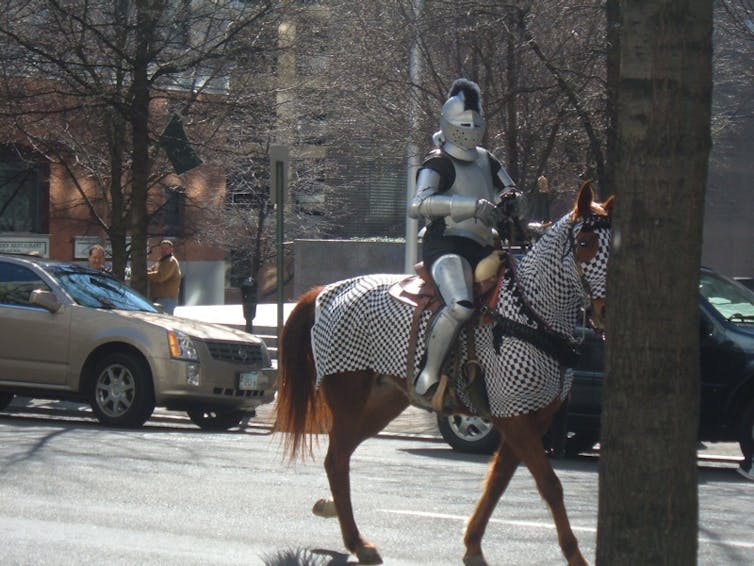Say what you like about knights and dames – they know how to cause a stir.
This week we witnessed one of those moments when satire loses the capacity to do its job. On Tuesday Prime Minister Tony Abbott announced Australia will reinstate a provision for nominating dames and knights of the Order of Australia, and that it will be the prime minister who makes the nominations.
Laughter ensued. Fearing concerted ridicule from all the latté-sipping elites in the land, parliament’s speaker Bronwyn Bishop forbade laughter in the house. Thousands of Twitter handles immediately incorporated aristocratic honorifics: “dame,” “sir” (or the prolific variant “ser”), “lady,” “lord,” et cetera.
Cue to the increasingly un-faceless Labor senator Sam Dastyari gleefully lampooning the whacky news on Tuesday evening. Cue to news editors everywhere dropping in grabs from Monty Python and the Holy Grail. Cue to Buzzfeed’s 37 Hilarious Responses to Knighthoods Being Brought Back To [sic] Australia.
Something about Australia’s political lens makes it easier for people to see conservatives as the funny team. Labor’s last genuinely laugh-friendly prime minister, Bob Hawke, discontinued the knighthoods in 1986. That was largely in response to the 1984 knighthood for Queensland’s late conservative premier Joh Bjelke-Petersen, who nominated himself. There is an enduring sense that dames and knights are part of a peculiar game of dressups adored by those on the right-side path to power.
Aside from the ridicule response, there have been three strong lines of criticism since Tuesday’s announcement.
First has been a widespread complaint about “retrograde” policy. Many non-government politicians – and quite a few Coalition backbenchers – have argued this move is taking Australia away from relying on its own ceremonial institutions.
For Australian republicans, that sense of winding back the clock is especially palpable. Not only is Abbott refusing to advance Australia towards political self-reliance, he is actively retreating from it — to an extent that exceeds even his mentor John Howard. Debates about historical advancement can be tricky, though, because people are wont to disagree which way is forwards, which backwards.

A second complaint has been directed to process. Abbott has foreclosed the Bjelke-Petersen scenario by insisting that politicians will not be eligible, but he has done nothing to foreclose the impressions of patronage that may now haunt these honours. Nominations for knight and dame will be at the prime minister’s discretion, albeit made in consultation with the chairman of the Order of Australia Council.
What is more, Abbott has revived these honours entirely off his own bat as prime minister. This detail has infuriated several Coalition backbenchers, who insist such a decision should go before the government party room for ratification (but not the parliament, one notes — apparently the governing party is sovereign).
A third, more politically biting, critique focuses on the strangeness and suddenness. Abbott promised voters a government of “no surprises,” as Labor MP Kelvin Thompson reminded radio listeners on Wednesday morning.

This announcement has clearly surprised huge numbers of people, and the evidence from talkback radio at least is that they have noticed. Will the electorate indulge “Daggy Dad” Abbott in this conservative fantasy play, or will it resent an unnecessary shark-jump in his first year in office?
He is taking a gamble: aside from hardline monarchists, it is hard to see many who will welcome the prime minister’s calculus here.
Any partisan critique of Abbott’s announcement runs into severe limits, though, when we consider how the previous system of national honours has failed to engage public imagination.
Sure, the Australian of the Year means something to many, as Adam Goodes has reminded us in 2014. On the other hand, how many strangers on the Northbourne Avenue bus would be able to explain just the difference between the categories Companion, Officer, and Member of the Order of Australia?
Nothing demonstrates this point more clearly than all the public ridicule. Who would even bother to make fun of the Order of Australia? (ABC TV’s The Games did obliquely, but are there any examples so far this century?)
In other words, it is clear that “dame” and “knight” resonate more deeply with contemporary Australian imaginations than the national honours some would claim we prefer.

What could be the attraction? “Knight” is the Middle English version of a European and Middle Eastern rank. Originally designating a class of soldiers who had the skills and wealth to use war-horses, its status evolved from primarily military to primarily honorific throughout medieval history. That evolution was essentially complete long before the onset of mobile artillery in the 15th Century AD spelled a doom for castle culture. We do not see many knights on horseback now.
“Dame” is also an old word, but the dame’s present station is essentially a late modern retrofit. As a government-bestowed title, it is a recently constructed feminine counterpart for the knight.
Perhaps the more important point here is that “dame” has worked: by contrast to the Order of Australia categories, people know the term well. Above all, they understand its implications of eminence. It is a clearly potent example of “invented tradition.”
Understanding terms is not the same as endorsing them, of course. There are good reasons to suspect that Abbott may encounter more negative traffic on this issue than he has allowed for. On the other hand, it does help to explain why there has been very little emotional urgency around the campaign to defend the existing system.

